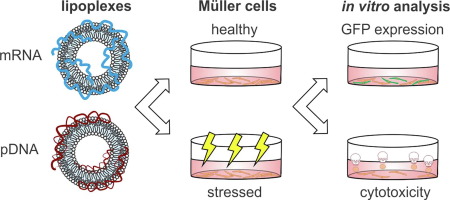European Journal of Pharmaceutics and Biopharmaceutics ( IF 4.9 ) Pub Date : 2020-03-12 , DOI: 10.1016/j.ejpb.2020.03.010 Christian J.F. Bertens , Chiara Martino , Marty C. van Osch , Arno Lataster , Aylvin J.A.A. Dias , Frank J.H.M. van den Biggelaar , Remco Tuinier , Rudy M.M.A. Nuijts , Marlies Gijs

|
Eye drops and ointments are the most prescribed methods for ocular drug delivery. However, due to low drug bioavailability, rapid drug elimination, and low patient compliance there is a need for improved ophthalmic drug delivery systems. This study provides insights into the design of a new drug delivery device that consists of an ocular coil filled with ketorolac loaded PMMA microspheres.
Nine different ocular coils were created, ranging in wire diameter and coiled outer diameter. Based on its microsphere holding capacity and flexibility, one type of ocular coil was selected and used for further experiments. No escape of microspheres was observed after bending the ocular coil at curvature which reflect the in vivo situation in human upon positioning in the lower conjunctival sac.
Shape behavior and tissue contact were investigated by computed tomography imaging after inserting the ocular coil in the lower conjunctival fornix of a human cadaver. Thanks to its high flexibility, the ocular coil bends along the circumference of the eye. Because of its location deep in the fornix, it appears unlikely that in vivo, the ocular coil will interfere with eye movements.
In vitro drug release experiments demonstrate the potential of the ocular coil as sustained drug delivery device for the eye. We developed PMMA microspheres with a 26.5 ± 0.3 wt % ketorolac encapsulation efficiency. After 28 days, 69.9% ± 5.6% of the loaded ketorolac was released from the ocular coil when tested in an in vitro lacrimal system. In the first three days high released dose (48.7% ± 5.4%) was observed, followed by a more gradually release of ketorolac. Hence, the ocular coil seems a promising carrier for ophthalmic drugs delivery in the early postoperative time period.
中文翻译:

眼线圈的设计,一种非侵入性药物输送的新设备
滴眼剂和药膏是眼部药物递送最常用的方法。然而,由于药物的生物利用度低,药物的快速消除和患者的依从性低,因此需要改进的眼科药物递送系统。这项研究为新型药物输送装置的设计提供了见识,该装置由填充了酮咯酸的PMMA微球的眼圈组成。
产生了九种不同的眼线圈,其线径和盘绕外径范围不等。基于其微球保持能力和柔韧性,选择了一种眼线圈,并用于进一步的实验。将眼线圈弯曲弯曲后,未观察到微球的逸出,这反映了人位于下结膜囊中后体内的情况。
将眼线圈插入人尸体的下结膜下穹ni后,通过计算机断层摄影成像研究形状行为和组织接触。由于其高柔韧性,眼线圈沿着眼睛的圆周弯曲。由于其在穹for深处的位置,在体内看来,眼线圈不太可能会干扰眼睛的运动。
体外药物释放实验证明了眼线圈作为眼睛持续药物输送装置的潜力。我们开发了具有26.5±0.3 wt%的酮咯酸封装效率的PMMA微球。28天后,在体外泪道系统中进行测试时,从眼圈释放了69.9%±5.6%的负载酮咯酸。在开始的三天中,观察到高释放剂量(48.7%±5.4%),然后逐渐释放出酮咯酸。因此,在术后早期,眼圈似乎是有希望的眼科药物输送载体。



























 京公网安备 11010802027423号
京公网安备 11010802027423号